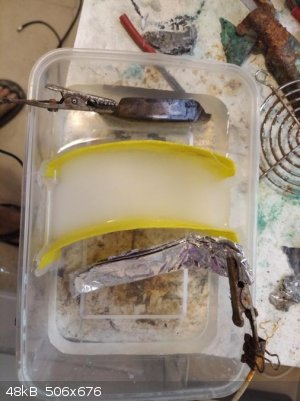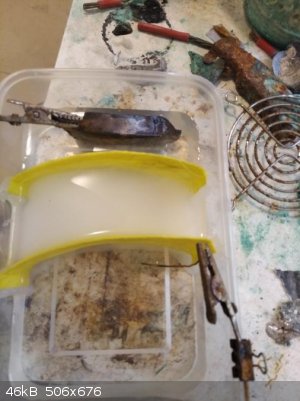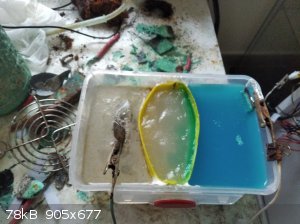| Pages:
1
2 |
mysteriusbhoice
Hazard to Others
  
Posts: 473
Registered: 27-1-2016
Member Is Offline
Mood: Became chemistry catboy Vtuber Nyaa
|
|
Good DIY selectivity membrane for cation exchange.
https://www.youtube.com/watch?v=y_QAemE3aX0
this video shows how to make membranes out of PVA and Na2(Terephthalate).
make sure to put desired starting material to be exchanged on the anode side and a drop of dillute NaOH on the cathode side.
works with chlorates and perchlorates converting common alkali salts like KClO3 and KClO4 into more exotic ones depending on the anode so a Copper
anode means Cu(ClO3)2 and Cu(ClO4)2.
[Edited on 28-7-2020 by mysteriusbhoice]
|
|
|
mysteriusbhoice
Hazard to Others
  
Posts: 473
Registered: 27-1-2016
Member Is Offline
Mood: Became chemistry catboy Vtuber Nyaa
|
|
other crosslinking agents can work like aldehydes but in this case I just used sodium borate and it works!!
|
|
|
mysteriusbhoice
Hazard to Others
  
Posts: 473
Registered: 27-1-2016
Member Is Offline
Mood: Became chemistry catboy Vtuber Nyaa
|
|
This membrane is only good for producing salts not acids!!
do not run any process that will produce acidic products like H2SO4 or even some organic acids.
If you want to use acids for this process instead of using borax you use aldehyde cross linking to prevent destruction in acidic media.
|
|
|
mysteriusbhoice
Hazard to Others
  
Posts: 473
Registered: 27-1-2016
Member Is Offline
Mood: Became chemistry catboy Vtuber Nyaa
|
|
new pics of my three compartment membrane cell to produce perchlorate/chlorate salts with no sodium/potassium contamination.
instead the polymer is applied only on one side and the other side remains fluffy also these thinner membranes have greater current flow but only time
will tell if they work just as well.
This setup is currently running NaCl also these membranes may find future use for my DIY HCl via reaction of Cl2 + H2 or simply as a chlorine
generator and the membranes themselves are resistant to alkali.
edit:
nvm cannot arrange it in this way because the acidic products will eat the membrane..
would have to ensure membrane is in contact with high pH at one side to keep it stable.
Anyone know any hydrogels which are stable at low pH and il try agar again because it was stableISH at low pH
 
[Edited on 31-7-2020 by mysteriusbhoice]
|
|
|
macckone
International Hazard
    
Posts: 2159
Registered: 1-3-2013
Location: Over a mile high
Member Is Offline
Mood: Electrical
|
|
How well does this membrane handle bases?
|
|
|
mysteriusbhoice
Hazard to Others
  
Posts: 473
Registered: 27-1-2016
Member Is Offline
Mood: Became chemistry catboy Vtuber Nyaa
|
|
These membranes actually perform best at higher pH and acidic pH kills them...
I still need to either use a different polymer hydrogel for the side facing the anode compartment or use agar since that seems to handle copper
chlorate well!.
agar membranes work well with acids but suck at dealing with bases and PVA is good dealing with bases and gets eaten by acids.
I wonder if its possible to melt sodium polyacrylate since I think that may work well with acids.
edit:
im gonna try an idea where I paint agar + terephthlic acid on the other side
[Edited on 31-7-2020 by mysteriusbhoice]
|
|
|
mysteriusbhoice
Hazard to Others
  
Posts: 473
Registered: 27-1-2016
Member Is Offline
Mood: Became chemistry catboy Vtuber Nyaa
|
|
New membrane for making exotic perchlorates/chlorates PVA membrane on cathode side resistant to bases and casted salted agar in middle to act as a
membrane resisting corrosion by weakly acidic products such as metal chlorides/chlorates/perchlorates.
crosslinked PVA hydrogel is excellent at preventing backflow of alkali hydroxides which normally would destroy the agar in a matter of hours.

The PVA membrane on the anode side is purely sacrificial and the support cloth only holds as support for the agar so it doesnt flop or warp!
[Edited on 1-8-2020 by mysteriusbhoice]
|
|
|
RogueRose
International Hazard
    
Posts: 1585
Registered: 16-6-2014
Member Is Offline
|
|
I have to admit, I thought your first video was a troll, lol. But I have ot say that I can not understand the 4th post, it looks like that membrane
is making an arch (bridge) from one side to the other (across the width), with the solution running underneath the "bridge".
I really want to try to make some TACC and TACP - so first comes the copper chlorate & perchlorates.
I REALLY wish there was a place to order NaClO3. I might start a business just to get some of this stuff b/c there's so much I want to do and it's
impossible to find this w/o some license (or it's CRAZY expensive - I saw sodium chlorate for $18-20/lb!
|
|
|
mysteriusbhoice
Hazard to Others
  
Posts: 473
Registered: 27-1-2016
Member Is Offline
Mood: Became chemistry catboy Vtuber Nyaa
|
|
Quote: Originally posted by RogueRose  | I have to admit, I thought your first video was a troll, lol. But I have ot say that I can not understand the 4th post, it looks like that membrane
is making an arch (bridge) from one side to the other (across the width), with the solution running underneath the "bridge".
I really want to try to make some TACC and TACP - so first comes the copper chlorate & perchlorates.
I REALLY wish there was a place to order NaClO3. I might start a business just to get some of this stuff b/c there's so much I want to do and it's
impossible to find this w/o some license (or it's CRAZY expensive - I saw sodium chlorate for $18-20/lb! |
the 4th post was to see if the membrane can allow for feed into neutral compartment but sadly this destroys the membrane in the acidic compartiment so
it cant work!!.
PVA membranes are actually only really good in alkaline conditions and agar is good for weakly acidic conditions but I need another option which can
work in acidic conditions other than buying nafion! because I wont.
The membrane is sealed off from solutio via some silicone caulk at the bottom so its not running under it at all.
I make all my NaClO3 from electrolysis of NaCl with added CaCl2 for pH control which precipitates Ca(OH)2 throughout the electrolysis keeping pH at
slightly below 7.
[Edited on 2-8-2020 by mysteriusbhoice]
|
|
|
papaya
National Hazard
   
Posts: 615
Registered: 4-4-2013
Member Is Offline
Mood: reactive
|
|
Hello mysteriusbhoice, I just want to ask have you ever considered using CMC-Na glue to make membranes, it's very cheap technical grade, and also CMC
itself (acid form) is insoluble in water somewhat like cellulose. Salt form if it is possible make into gel will inherently be a Na ion conductor,
while acid form (made from Na-salt gel somehow?) could act as a H+ ion conductor. I'm pretty sure acid form should be immune to acid, becouse it's
acid itself 
Also I don't see the purpose of terephtalate, what does it add ?
|
|
|
mysteriusbhoice
Hazard to Others
  
Posts: 473
Registered: 27-1-2016
Member Is Offline
Mood: Became chemistry catboy Vtuber Nyaa
|
|
Quote: Originally posted by papaya  | Hello mysteriusbhoice, I just want to ask have you ever considered using CMC-Na glue to make membranes, it's very cheap technical grade, and also CMC
itself (acid form) is insoluble in water somewhat like cellulose. Salt form if it is possible make into gel will inherently be a Na ion conductor,
while acid form (made from Na-salt gel somehow?) could act as a H+ ion conductor. I'm pretty sure acid form should be immune to acid, becouse it's
acid itself 
Also I don't see the purpose of terephtalate, what does it add ? |
terephthalate apparently is not needed just had some laying around and thought as a barely soluble material containing Na Ions could make the pva more
resistant to acid but NOPE!!.
as for CMC I will probably buy some and try it out
apparently some blue gel ice packs contain CMC gel!!
I saw some in the grocery will try that first for the caveman option!!
[Edited on 2-8-2020 by mysteriusbhoice]
|
|
|
papaya
National Hazard
   
Posts: 615
Registered: 4-4-2013
Member Is Offline
Mood: reactive
|
|
Does somebody know what kind of chemical is added to Na-CMC to gelate ? As far as I know it makes viscous solutions, but a gel ?
|
|
|
mysteriusbhoice
Hazard to Others
  
Posts: 473
Registered: 27-1-2016
Member Is Offline
Mood: Became chemistry catboy Vtuber Nyaa
|
|
Updated video on Ion exchange membranes
https://www.youtube.com/watch?v=dR7fW5J7njA
simpler thinner and more ionically conductive and also cheaper!!
|
|
|
macckone
International Hazard
    
Posts: 2159
Registered: 1-3-2013
Location: Over a mile high
Member Is Offline
Mood: Electrical
|
|
Have you had a chance to try the same with agar and an acid?
I am thinking agar with formaldehyde and sodium bisulfate for an acid gel but I have not tried it to see if it will set properly. The agar
formaldehyde should be pretty much indestructible by acid at reasonable levels (<10%).
|
|
|
mysteriusbhoice
Hazard to Others
  
Posts: 473
Registered: 27-1-2016
Member Is Offline
Mood: Became chemistry catboy Vtuber Nyaa
|
|
agar shrinks way too much as it dries and overall the current PVA membrane can widthstand atleast acid salts which is good enough.
I just put agar inbetween if I need strong acids and agar itself handles acids semi well but doesnt handle hydroxides hence the PVA so by compositing
2 membranes I do have 1 setup capable of making good exotic chlorates and perchlorates.
these PVA membranes do that too but are thinner and more ionically conductive good for chloroalkali cells.
|
|
|
macckone
International Hazard
    
Posts: 2159
Registered: 1-3-2013
Location: Over a mile high
Member Is Offline
Mood: Electrical
|
|
I am looking for something that can handle moderate levels of sulfuric acid.
The two membrane sodium sulfate process is interesting and appears to be in commercial use.
It uses both a cation and anion membrane to produce sulfuric acid and sodium hydroxide from sodium sulfate.
|
|
|
mysteriusbhoice
Hazard to Others
  
Posts: 473
Registered: 27-1-2016
Member Is Offline
Mood: Became chemistry catboy Vtuber Nyaa
|
|
Quote: Originally posted by macckone  | I am looking for something that can handle moderate levels of sulfuric acid.
The two membrane sodium sulfate process is interesting and appears to be in commercial use.
It uses both a cation and anion membrane to produce sulfuric acid and sodium hydroxide from sodium sulfate. |
you can use a copper anode to form copper sulfate first using this PVA membrane then collect pure CuSO4 crystals.
Dissolve these in water and electrolyze normally to get back the copper and get H2SO4 no need to make it straight from sodium sulfate because that
process will always end in an equilibrium.
|
|
|
macckone
International Hazard
    
Posts: 2159
Registered: 1-3-2013
Location: Over a mile high
Member Is Offline
Mood: Electrical
|
|
Quote: Originally posted by mysteriusbhoice  | Quote: Originally posted by macckone  | I am looking for something that can handle moderate levels of sulfuric acid.
The two membrane sodium sulfate process is interesting and appears to be in commercial use.
It uses both a cation and anion membrane to produce sulfuric acid and sodium hydroxide from sodium sulfate. |
you can use a copper anode to form copper sulfate first using this PVA membrane then collect pure CuSO4 crystals.
Dissolve these in water and electrolyze normally to get back the copper and get H2SO4 no need to make it straight from sodium sulfate because that
process will always end in an equilibrium. |
Using that method requires twice the electricity and produces very weak sulfuric acid. The two membrane method is much more efficient and can produce
stronger acid provided you have a good anion membrane.
|
|
|
mysteriusbhoice
Hazard to Others
  
Posts: 473
Registered: 27-1-2016
Member Is Offline
Mood: Became chemistry catboy Vtuber Nyaa
|
|
I thought of one other possibility.
what if we take our current PVA membrane make that the membrane in the cathode side then we can CAST plaster of paris as the anion membrane which
should resist H2SO4 and be conductive ionically to the solution therefore with this in mind the PVA membrane will be preserved!!
|
|
|
macckone
International Hazard
    
Posts: 2159
Registered: 1-3-2013
Location: Over a mile high
Member Is Offline
Mood: Electrical
|
|
That is a good possibility.
Especially if we add something to the plaster that prevents it from deteriorating under exposure to water.
I will have to think on additional binders.
One that comes to mind is polypropylene fiber, fiberglass or PMMA fiber.
It might also be possible to make a pmma/gypsum composite film from pmma resin.
|
|
|
mysteriusbhoice
Hazard to Others
  
Posts: 473
Registered: 27-1-2016
Member Is Offline
Mood: Became chemistry catboy Vtuber Nyaa
|
|
Quote: Originally posted by macckone  | That is a good possibility.
Especially if we add something to the plaster that prevents it from deteriorating under exposure to water.
I will have to think on additional binders.
One that comes to mind is polypropylene fiber, fiberglass or PMMA fiber.
It might also be possible to make a pmma/gypsum composite film from pmma resin. |
remember that the plaster wont be in pure water but in a sat soln of Na2SO4 which means its deterioration will be quite slow but sure maybe you can
add a binder like CEMENT which ive made succesfully into a membrane.
adding plastic fibers to the plaster also would help but yea I hope to see a video on your sulfuric acid from Na2SO4 project also btw you can easily
make Na2SO4 from NaOH + CaSO4 incase its hard to buy for some reason.
[Edited on 15-9-2020 by mysteriusbhoice]
|
|
|
macckone
International Hazard
    
Posts: 2159
Registered: 1-3-2013
Location: Over a mile high
Member Is Offline
Mood: Electrical
|
|
Cement is attacked by Na2SO4 and H2SO4.
Na2SO4 is a waste product with NaHSO4 from making HCl gas.
I got plenty. I am trying to do something useful with it.
|
|
|
mysteriusbhoice
Hazard to Others
  
Posts: 473
Registered: 27-1-2016
Member Is Offline
Mood: Became chemistry catboy Vtuber Nyaa
|
|
Quote: Originally posted by macckone  | Cement is attacked by Na2SO4 and H2SO4.
Na2SO4 is a waste product with NaHSO4 from making HCl gas.
I got plenty. I am trying to do something useful with it. |
I just created a really good membrane using PVA that survives 37% HCl
you need pure PVA solution which is also sold as clear glue.
you then take this and mix with citric acid and cook it in the stove until the citric acid dissolves and you get a syrup.
take this syrup and paint it into the membrane scaffold or even onto Al foil then take your NaOH bath and dunk either one and you will end up with a
strong rigid polymer that feels like rubber and tastes salty and can survive acids.
|
|
|
mysteriusbhoice
Hazard to Others
  
Posts: 473
Registered: 27-1-2016
Member Is Offline
Mood: Became chemistry catboy Vtuber Nyaa
|
|
Heres the process on how to make the new Citric acid crosslinked PVA which is resistant to strong acids as one steps involves washing with HCl and
tested it with 20% and 37% hCl it doesnt even dissolve.
https://www.youtube.com/watch?v=UdQ9OThC7ZI
|
|
|
mysteriusbhoice
Hazard to Others
  
Posts: 473
Registered: 27-1-2016
Member Is Offline
Mood: Became chemistry catboy Vtuber Nyaa
|
|
Quote: Originally posted by macckone  | Cement is attacked by Na2SO4 and H2SO4.
Na2SO4 is a waste product with NaHSO4 from making HCl gas.
I got plenty. I am trying to do something useful with it. |
I have the solution for u man
New PVC porous barrier for production of acids like H2SO4 from Na2SO4 or CaSO4 and or batch mode chloro alkali process.
https://www.youtube.com/watch?v=foQHygE2Mkw
|
|
|
| Pages:
1
2 |